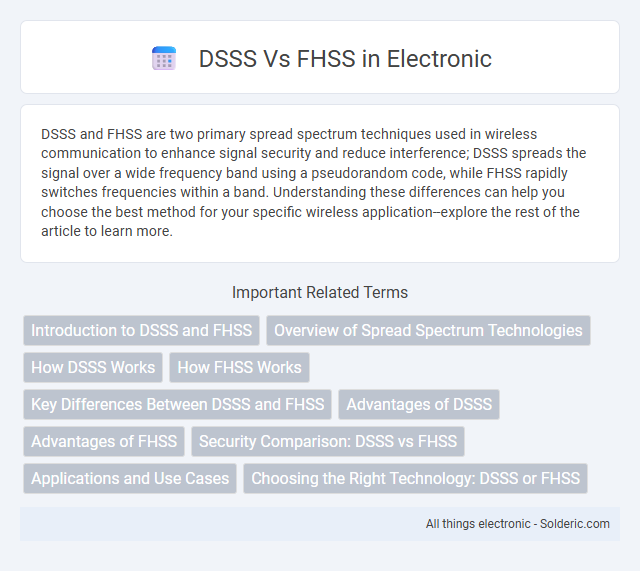DSSS and FHSS are two primary spread spectrum techniques used in wireless communication to enhance signal security and reduce interference; DSSS spreads the signal over a wide frequency band using a pseudorandom code, while FHSS rapidly switches frequencies within a band. Understanding these differences can help you choose the best method for your specific wireless application--explore the rest of the article to learn more.
Comparison Table
| Feature | DSSS (Direct Sequence Spread Spectrum) | FHSS (Frequency Hopping Spread Spectrum) |
|---|---|---|
| Spreading Technique | Spreads signal using a pseudo-random noise code over a wide frequency band simultaneously. | Transmits signal by rapidly switching ("hopping") between frequencies within a band. |
| Interference Resistance | High resistance due to wideband spreading and processing gain. | Good resistance by frequency agility and avoiding narrowband interference. |
| Bandwidth Usage | Wide continuous bandwidth consumption. | Narrow bandwidth per hop, but overall wide band used across hops. |
| Security | Moderate; depends on secrecy of code sequence. | Higher; frequency hopping pattern is difficult to predict. |
| Complexity | Moderate complexity in implementation. | Higher complexity due to synchronization and hopping control. |
| Typical Applications | GPS, CDMA cellular, WLAN (802.11b). | Bluetooth, military communication, cordless phones. |
| Data Rate | Supports higher data rates due to continuous bandwidth. | Generally lower data rates due to hopping delays. |
Introduction to DSSS and FHSS
Direct Sequence Spread Spectrum (DSSS) and Frequency Hopping Spread Spectrum (FHSS) are two primary techniques used in wireless communication to enhance signal reliability and security. DSSS transmits data by spreading it across a wide frequency band using a pseudorandom noise code, reducing interference and improving resistance to eavesdropping. FHSS rapidly switches the carrier frequency among many channels within a band, making Your communication more resilient to narrowband interference and frequency-selective fading.
Overview of Spread Spectrum Technologies
Direct Sequence Spread Spectrum (DSSS) and Frequency Hopping Spread Spectrum (FHSS) are two primary spread spectrum technologies used to enhance communication security, resistance to interference, and signal robustness. DSSS spreads the signal by multiplying the data with a pseudorandom noise code, resulting in a wider bandwidth transmission that resists eavesdropping and narrowband interference. FHSS rapidly switches the carrier frequency across multiple channels in a pseudorandom sequence, improving resistance to jamming and allowing multiple users to share the same bandwidth with minimal interference.
How DSSS Works
Direct Sequence Spread Spectrum (DSSS) works by multiplying the data signal with a pseudo-random noise spreading code, significantly increasing the bandwidth of the transmitted signal. This process spreads the signal over a wider frequency range, making it more resistant to interference and jamming compared to narrowband signals. The receiver uses the same pseudo-random code to correlate and recover the original data, enabling secure and robust communication.
How FHSS Works
Frequency-Hopping Spread Spectrum (FHSS) operates by rapidly switching the carrier frequency among many distinct frequencies within a wide band, following a pseudorandom sequence known only to the transmitter and receiver. This technique enhances resistance to interference, reduces the risk of interception, and minimizes signal fading by dispersing the signal over multiple channels. Your communication remains secure and reliable as FHSS continuously changes frequencies, preventing unauthorized access and maintaining signal integrity.
Key Differences Between DSSS and FHSS
DSSS (Direct Sequence Spread Spectrum) spreads the signal by multiplying the data with a pseudo-random noise code, resulting in a wider bandwidth and improved resistance to narrowband interference. FHSS (Frequency Hopping Spread Spectrum) rapidly switches the carrier frequency among many channels in a predetermined sequence, enhancing security and reducing the risk of interception and jamming. Key differences include DSSS's constant bandwidth usage versus FHSS's dynamic frequency changes, with DSSS offering better signal-to-noise ratio and FHSS providing robust multi-path fading mitigation.
Advantages of DSSS
DSSS (Direct Sequence Spread Spectrum) offers superior resistance to narrowband interference and multipath fading, ensuring more reliable data transmission in noisy environments. Its inherent processing gain enhances signal security and reduces the chance of eavesdropping compared to FHSS (Frequency Hopping Spread Spectrum). You benefit from higher data rates and improved signal quality, making DSSS ideal for applications requiring robust communication.
Advantages of FHSS
FHSS (Frequency Hopping Spread Spectrum) offers robust resistance to narrowband interference and eavesdropping due to its rapid frequency changes across a wide band. Its inherent security and low probability of interception make it ideal for military and secure communication systems. FHSS also provides better performance in multipath environments, minimizing signal fading and improving overall reliability.
Security Comparison: DSSS vs FHSS
DSSS (Direct Sequence Spread Spectrum) offers robust protection against narrowband interference by spreading the signal over a wide frequency band, making unauthorized interception and jamming more difficult. FHSS (Frequency Hopping Spread Spectrum) enhances security through rapid frequency changes that reduce the chances of interception and provide resistance to deliberate jamming attacks. Your choice between DSSS and FHSS depends on specific security needs, with FHSS generally offering stronger anti-jamming capabilities while DSSS provides better protection against signal interception.
Applications and Use Cases
Direct Sequence Spread Spectrum (DSSS) excels in environments requiring high data rates and low latency, making it ideal for Wi-Fi networks, GPS systems, and cordless phones. Frequency Hopping Spread Spectrum (FHSS) offers robust resistance to interference and eavesdropping, favored in military communications, Bluetooth devices, and industrial automation. Your choice between DSSS and FHSS depends on specific application needs such as bandwidth efficiency, security, and environmental interference.
Choosing the Right Technology: DSSS or FHSS
Choosing between DSSS (Direct Sequence Spread Spectrum) and FHSS (Frequency Hopping Spread Spectrum) depends on your specific wireless communication needs and environmental factors. DSSS offers higher data rates and better resistance to narrowband interference, making it ideal for environments with stable frequency bands and higher bandwidth requirements. FHSS excels in environments with high interference or security concerns by rapidly switching frequencies, providing robust signal protection and reducing the risk of eavesdropping.
DSSS vs FHSS Infographic

 solderic.com
solderic.com